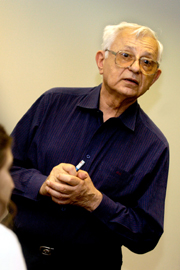NIH Award from the National Cancer Institute
Dissection of the Functions of Herpes Simplex Virus ICP0
- Principal Investigator: Bernard Roizman, ScD, Joseph Regenstein Distinguished Service Professor of Virology; Chairman, Viral Oncology Laboratory
- Start Date: August 1, 2009
- Total Award Amount: $70,100
Project Description
The 775 residue infected cell protein No.O (ICPO) of herpes simplex virus 1 (HSV-1) is a multifunctional protein known primarily as a promiscuous transactivator. Studies initiated during the previous grant period demonstrated that it contains ubiquitin ligase sites mapping in exon 2 (residues 20- to 241) and near the carboxyl terminal of exon 3 (residues 600 to 775). The objective of the studies done during the current period were to (a) define the role of ICPO as an unbiquitin ligase, (b) investigate the role of ICPO during early stages of infection, and, (c) identify the functions encoded in the uncharted domains (residues 242-500) of ICPO.
We have accomplished the following: (i) We have demonstrated that one of the ICPO ubiquitin ligase activities targets PML. By specifically degrading PML, HSV blocks exogenous interferon from activating antiviral responses, (ii)We have demonstrated for the first time that the role of ICPO is similar to that of histone deacetylase (HDAC) inhibitors. ICPO interacts with the represser complex CoREST/REST/HDAC1-2 to dislodge HDAC1-2 from this complex. In essence, on release of viral DNA from virions into the nucleus, it is confronted by numerous cellular proteins whose function it is to either express of shutoff viral DNA. HSV encodes three proteins, ccTIF (VP16) which is brought into the nucleus to enable the expression of a genes, ICPO, which blocks the silencing of all downstream genes, and US3 protein kinase (recently shown to phopshorylate HDAC1-2) to enable gene expression in transduced cells. All DNA viruses have a similar problem - howto block silencing, of its genes by cellular repressers. We have demonstrated that the problem is real and that viruses have found a way to solve this problem, (iii) The cell surface is a giant antenna that radiates signals to the environment and also conveys signals from the environment to the cell. Studies of previously uncharted domain of ICPO led to the discovery of motifs for binding SH3 domains. This led to a fundamental discovery that the virus targets surface receptors in many different ways. CIN85 and Cbl are blocked from cycling to the cell surface. TNFa receptor disappears because the protein is short lived and the virus degrades its mRNA. Interferon y receptor appears to be phosphorylated by a viral protein kinase and studies are in progress to determine whether this results in inactivation of the receptor.
Our objective in the next grant interval are to (i) define role of ICPO in blocking the attempt by the host cell to silence the expression of viral genes, (ii)define the role of anti silencing activity of ICPO in establishment of latency, reactivation, and pathogenicity and (iii) define the consequences of the interaction of ICPO with SH3 domain proteins. The studies on ICPO are central to an understanding of the mechanisms by which viruses thwart fundamental mechanisms of cellular defences to infection.
This award is funded under the American Recovery and Reinvestment Act of 2009, NIH Award number: 3R37CA078766-12S2

Bernard Roizman, ScD,
Joseph Regenstein Distinguished Service Professor of Virology; Chairman, Viral Oncology Laboratory
